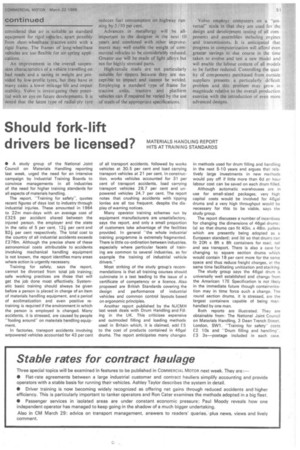Should fork-lift drivers be licensed?
Page 53

If you've noticed an error in this article please click here to report it so we can fix it.
MATERIALS HANDLING REPORT HITS AT TRAINING STANDARDS
• A study group of the National Joint Council on Materials Handling reporting last week, urged the need for an intensive campaign by Industrial Training Boards to convince managements in all industries of the need for higher training standards for all aspects of materials handling.
The report, "Training for safety", quotes recent figures of days lost to industry through industrial injuries. These amounted in 1964 to 22m man days with an average cost of £325 per accident shared between the injured person. the employer and the state in the ratio of 5 per cent, 12+ per cent and 82+ per cent respectively. The total cost to the country of all industrial accidents exceeds £276m. Although the precise share of these astronomical costs attributable to accidents involving mechanical handling equipment is not known, the report identifies many areas where action is urgently necessary.
Training for safety, says the report, cannot be divorced from total job training; safe working practices are those that will get the job done most effectively. Systematic basic training should always be given before a person is placed in charge of an item of materials handling equipment, and a period of acclimatization and even positive retraining is required if the environment in which the person is employed is changed. Many accidents, it is stressed, are caused by people -fooling around" on materials handling equipment.
In factories, transport accidents involving empowered vehicles accounted for 43 per cent of all transport accidents, followed by works vehicles at 30.5 per cent and load carrying transport vehicles at 21 per cent. In construction, works vehicles accounted for 31 per cent of transport accidents, load carrying transport vehicles 28.7 per cent and unpowered vehicles 24.7 per cent. The report notes that crushing accidents with tipping lorries are all too frequent, despite the display of warning notices.
Many operator training schemes run by equipment manufacturers are unsatisfactory, says the report. and only a small proportion of customers take advantage of the facilities provided. In general "the whole industrial training programme is extremely fragmented. There is little co-ordination between industries, especially where particular facets of training are common to several industries, as for example the training of industrial vehicle drivers."
Most striking of the study group's recommendations is that all training courses should culminate in a test leading to the issue of a certificate of competency or a licence. Also proposed are British Standards covering the design and performance of industrial vehicles and common control layouts based on ergonomic principles.
Another report published by the NJCMH last week deals with Drum Handling and Filling in the UK. This criticizes expensive and outmoded filling and loading methods used in Britain which, it is claimed, add £5 to the cost of products contained in 46gal drurhs. The report anticipates many changes in methods used for drum filling and handling in the next 5-10 years and argues that relatively large investments in new methods would pay off if little more than 6d an hour labour cost can be saved on each drum filled.
Although automatic warehouses are in use for small-sized packages, very high capital costs would be involved for 46gal drums and a very high throughput would be necessary for this to be viable, says the study group.
The report discusses a number of incentives for changing the dimensions of 46ga1 drums: (a) so that drums can fit 40in. x 48in. pallets which are presently being adopted as a European standard; and (b) so that drums can fit 20ft x Elft x 8ft containers for road, rail and sea transport. There is also a case for changing to square section drums which would contain 18 per cent more for the same space and thus reduce freight charges, at the same time facilitating unitization and stacking.
The study group says the 46ga1 drum is universally well established and change from the American 17E Specification is not likely in the immediate future though containerization may in time force such a change. The round section drums, it is stressed, are the largest containers capable of being manhandled by one man.
Both reports are illustrated. They are obtainable from: The National Joint Council on Materials Handling, 3 Dean Trench Street, London, SW1. "Training for safetycosts
£2 10s and "Drum filling and handling",
£3 3s—postage included in each Case.












































































































